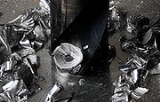
Drilling and threading
Overview
Cutting
Cutting is the separation of a physical object, or a portion of a physical object, into two portions, through the application of an acutely directed force. An implement commonly used for cutting is the knife or in medical cases the scalpel...
process that uses a drill bit
Drill bit
Drill bits are cutting tools used to create cylindrical holes. Bits are held in a tool called a drill, which rotates them and provides torque and axial force to create the hole. Specialized bits are also available for non-cylindrical-shaped holes....
to cut or enlarge a hole in solid materials. The drill bit is a multipoint, end cutting tool
Cutting tool
In the context of machining, a cutting tool is any tool that is used to remove material from the workpiece by means of shear deformation. Cutting may be accomplished by single-point or multipoint tools. Single-point tools are used in turning, shaping, plaining and similar operations, and remove...
. It cuts by applying pressure
Pressure
Pressure is the force per unit area applied in a direction perpendicular to the surface of an object. Gauge pressure is the pressure relative to the local atmospheric or ambient pressure.- Definition :...
and rotation to the workpiece, which forms chips
Swarf
Swarf, also known as turnings, chips, or filings, are shavings and chippings of metal — the debris or waste resulting from metalworking operations including milling and grinding. It can usually be recycled, and this is the preferred method of disposal due to the environmental concerns regarding...
at the cutting edge.
Drilled holes are characterized by their sharp edge on the entrance side and the presence of burrs on the exit side (unless they have been removed). Also, the inside of the hole usually has helical feed marks.
Drilling may affect the mechanical properties of the workpiece by creating low residual stress
Residual stress
Residual stresses are stresses that remain after the original cause of the stresses has been removed. They remain along a cross section of the component, even without the external cause. Residual stresses occur for a variety of reasons, including inelastic deformations and heat treatment...
es around the hole opening and a very thin layer of highly stressed and disturbed material on the newly formed surface.

